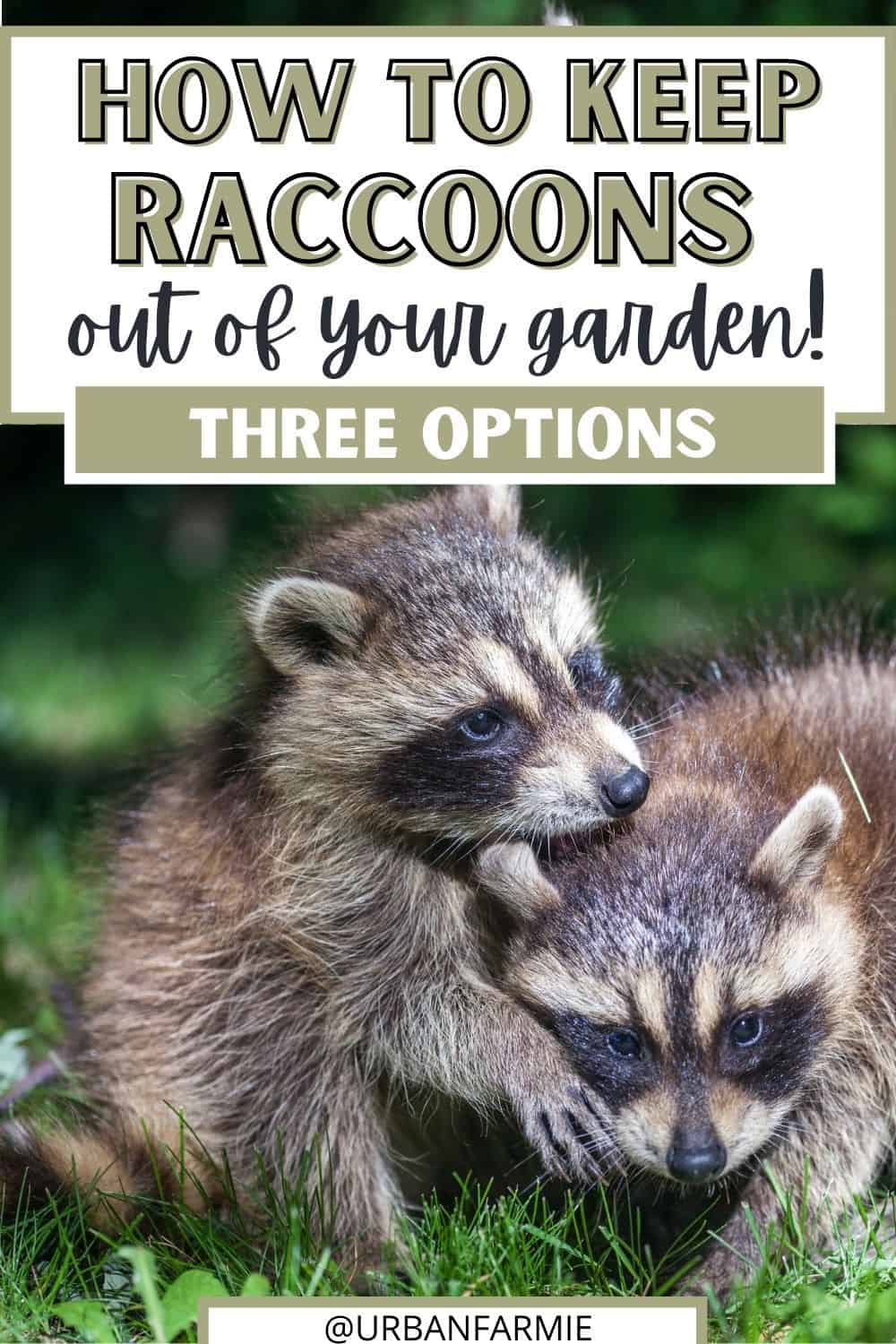I live in Seattle, and I found out the hard way that we have a raccoon in the empty lot behind my house.
Ciscoe (as we named him, politely after the famous Seattle gardening legend) is vicious! He tore through the lawn we originally planted, and the first raised bed I planted. So, I tried everything to figure out how I can keep this raccoon out of my garden. I finally seem to have succeeded.
So, I wanted to write this post to summarize my experiences. It covers tips on recognizing if you have racoons, outlines what worked and didn't work, and my final recommendations for keeping raccoons out.

How to identify raccoons
Raccoons are nocturnal creatures, so they feed at night. This makes it difficult to identify them sometimes. There are five things I observed when Ciscoe started running through our backyard:
- Distinct paw tracks — racoons have distinct five-toed paws, so they'll leave very distinct paw tracks in your garden
- Poop — racoon poop is disgusting, but also dangerous. They designate specific areas as bathroom spots (also called racoon latrines) I won't scar you with images, but racoon poop is quite distinct (but Google it in case you spot this in your yard to make sure it's a racoon)
- Trash cans being looted - racoons love to go through trash to get to food and other shiny things. If you had a trash can turned over in your yard, it almost certainly is a sign of racoons.
- Holes - lots and lots of holes. If you find that your lawn, yard, or mulch pile has holes - it could be a raccoon. They love digging up stuff to get to grubs to eat. Case in point, one totally uprooted my Brussels Sprouts and cabbage plants just in vain.
- Dead livestock and animals. Raccoons can raid chicken coops, steal eggs or even kill your chickens.

Why are racoons a problem?
Racoons are persistent critters that get wildly creative when they decide they want to ravage your garden. They can climb wild heights (one scaled a 20 feet trellis fence in my backyard). They also jump, and run (as I found one day when I saw Ciscoe in my backyard).
Raccoons are nocturnal and omnivorous - so they eat your plants, fish if you have a pond, and dig up other plants to get to grubs. They also have human-like hands, so that's another thing to watch out for (because they can "open" things)
Raccoons are quite dirty and carry a host of diseases. After bats, they're linked to the most number of cases of rabies. They carry roundworm, which is left behind in their poop. This is especially dangerous if your kids are playing in your backyard. They also carry parasites.
How do you keep racoons out of your garden?
The best way to ensure minimal plant damage is to prevent or deter the raccoon from entering your garden altogether. You can do this with fencing (regular or electric) or other humane methods (e.g., predator urine, ultrasonic motion-activated sound, light or watering devices, cayenne pepper, ammonia, and other strong aromatic substances, etc.)
First, you'll want to identify where the raccoon is entering your garden. We found a gap in our high trellis fence (facing an empty construction lot). This will help you target solutions (especially in a large yard).
I tried many options, and found that a combination of the following worked best for me (versus one specific method).
- Chicken wire fencing (around my raised beds)
- Ultrasonic motion-activated sound device
- Strong smelling substances (e.g., cayenne pepper, ammonia, and predator urine)
Regular fencing and crop cages
Most states have regulations on fence heights. So I couldn't change the actual fence of my garden. Instead, I built a faux fence around my raised beds using PVC pipes, stakes, connectors, and chicken wire.
But hey, this is a really janky, DIY method. Honestly, I'm just proud that I got it done. So, these pictures are to inspire the folks who aren't the most handy. If you have someone who loves DIY, get them to help, especially with flattening the chicken wire! And if you care how it looks: you can pick up a nice one at Gardener's Supply (like these ones)
I looked up a range of options for fencing, and found that this was the most cost efficient. So, I bought a sufficiently heavy gauge of chicken wire (that raccoons cannot gnaw through). First, I built square frames with PVC pipes and used zip ties to tie chicken wire across them. I made these 4' tall to make sure my taller plants will have room to grow.
Then, I used wooden stakes to build a "cage" around my raised beds. I zip-tied each PVC frame onto that wooden cage on three sides. On the fourth side (i.e., the one from where I would normally access my raised bed) - I zip-tied the PVC frame just to one of the stakes (instead of both). This way, the frame acts like a door that I can swing open!
Word of caution: if you read this and thought, wow, that's a convenient door! Apparently, so did Ciscoe. So I had to use earth staples to make sure that the "door" was anchored into the ground. Don't forget this step. Or else, you might find the raccoon rummaging through crops INSIDE the cage after having opened the door the same way you do. Welp.
Three tips for building crop cages:
- Decide if you want a cage that swings open or one you can "lift" off the raised bed (essentially a large cloche). The ones with doors allow for taller cages (great if you're growing tomatoes or Brussels sprouts). The ones that lift open are much easier to pull together.
- Make sure you can reach the farther end of the bed from the side that opens! Once all your plants are in, you'll be leaning over them to reach the ones in the back. So make sure to not make the cage too wide. Alternatively, build "swing doors" on either side of the raised bed.
- Pick the right gauge of chicken wire. I picked ½" opening, 19 gauge wire. You'll want 1" or smaller openings (or else, raccoons can put their chubby fingers through it). And, you'll want 19 gauge or thicker. Smaller the gauge, thicker the wire!
Motion-activated devices
There are many varieties of these (sound emitting, light emitting or water sprinkling). I got the sound emitting one. I placed it facing the exact spot where the raccoon was entering my garden. Then, I turned it to the right frequency (even I could hear a slight hum). One day, I spotted the raccoon stop and try to get away after hearing the sound. But, to be honest, this was the weakest of all the options I tried.
I've heard of other friends having success with motion-activated lights, or water sprinklers, or leaving a light and radio turned on in the yard overnight. My raccoon didn't seem to be bothered at all by these options so I didn't find them particularly helpful.
Strong smelling substances
I tried a laundry list of sharp smelling substances. I tried many of them in tandem, so it's hard to tell which ones were most effective. Raccoons have sensitive noses. So, when they touch these substances, and then touch their faces, it burns a bit. I researched and found this was similar to eating a hot chili - so uncomfortable but not lethal. The strong smell then deters them from moving closer to the substance.
I found that a combination of cayenne pepper, Irish Spring bar soap, and predator urine seems to have done the trick. They each have their own pros and cons.
- Cayenne: This is the easiest option to find - you can pick up a giant gallon for four to five dollars. You sprinkle this around the perimeter of the garden. However, in a place like Seattle where we get insane rainfall, it was a definite hassle to keep sprinkling cayenne.
- Irish Spring bar soap: This was a really interesting tidbit I found during my research. Apparently, raccoons hate the ingredients in this soap. So I cut them into small chunks and scattered them around my garden.
- Predator urine: Got some coyote urine online after much research, and I have to say - these things smell VILE. The rationale is straightforward: raccoons think that there's a predator nearby and leave your stuff alone. I soaked some dryer balls and threw them in a sock and stapled them to the corners where I thought the raccoons were.
Electric fencing and other options
Electric fencing is the most expensive, but also most 'tried and tested' way to keep raccoons out of your garden. However, this option might be quite difficult depending on the size of the yard. I also didn't want to injure the animal in case it had a nest nearby. So, I went with some of the more humane / natural options mentioned above.
Other options that I tried, which didn't work whatsoever:
- Raccoon spikes (he just walked right over them like an acupuncture mat)
- Motion-activated water sprinklers (what a nice sprinkler shower!)
- "Repellant" granules (like ammonia, etc.) - he literally walked right over
- Leaving the light on with a radio - zero effect
Let us know if you plan to try one of these methods to keep racoons out of your garden (or a different one!)










Comments
No Comments